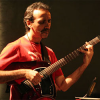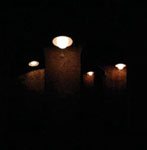Home » Jazz Articles » Live Review » Friday Night at Thelonious
Friday Night at Thelonious
 It's Friday night at Thelonious, a second-floor jazz venue in Buenos Aires' tony Palermo district, and the doors are about to open. The staff huddles together, slurping up spaghetti and smoking Lucky Strikes, the quintet works through a few tunes for the sound check, and the cocktail tables and plush couches lie in wait.
It's Friday night at Thelonious, a second-floor jazz venue in Buenos Aires' tony Palermo district, and the doors are about to open. The staff huddles together, slurping up spaghetti and smoking Lucky Strikes, the quintet works through a few tunes for the sound check, and the cocktail tables and plush couches lie in wait. Like in other cultural hotbeds the world over, jazz has found its niche in Buenos Aires. In a city where the local music, tango, is the most famous cultural export, jazz has had to do what jazz does best—grow beneath the surface in jam sessions and small clubs, cultivate a fervent group of practitioners and followers, and, most importantly, adapt.
Argentine jazz is unmistakably rooted in the music's tradition, but in nearly every performance, I hear a rhythm, a harmonic flourish, or a melodic phrase that sounds unsettling—a new idea grasping onto the ever-morphing form of the music. Many musicians in Argentina have fused jazz with other idioms to create a hybrid language—the new tango of Astor Piazzolla, the "ethno-tango-jazz" of Dino Saluzzi and Quique Sinesi. Yet, even the most straight-ahead jazz musicians have shades of this different thing, which is what makes Argentine jazz vital and worthwhile.
Buenos Aires has a host of different kinds of jazz venues, a fact that speaks to its health as a scene. There are tiny joints that host jams and small groups, there are posh jazz restaurants that have steep covers and name acts, there's even a private home that on Friday nights is turned into a living room performance space—a 1920s Chicago "rent party" translated to 21st-century South America.

Back at Thelonious, guitarist Alejandro Demogli and his quintet have just taken the stage. It's a sold-out club, standing-room-only in the back. The quintet is here in support of its newly recorded, soon-to-be-released album, Just Songs (AndesRecords, 2008), a collection of Demogli compositions that is representative of the cross-cultural pollination that defines Argentine jazz.
The Buenos Aires-born and raised Demogli studied jazz at Berklee, played in the bands of Bob Moses and Richard Davis, and has had a long-standing collaboration with bassist Hill Greene. Yet Demogli is also adept at incorporating candomblé, chacarera, and tango into his compositions and improvisations.
On "Osiris," the night's first number, the quintet began with a quick-stepped jazz waltz that picked up steam as it broke into a chacarera clave. The switch into this Argentine folkloric beat was accompanied by the piling on of harmonic layers, propelling the music close to muddy discord. Then, just as it sounded like everything was on the verge of turning into sonic mush, a quick flip into swinging common time brought the music hurtling back towards lucidity. The music, dense and agitated before, had become buoyant and relaxed, allowing the listener a respite before the form repeated once again.
"Osiris" may have spanned a wide rhythmic vocabulary, but it never felt forced. Demogli insists that these multiple textures arose organically—a reflection of the way he hears music, rather than a deliberate attempt at cultural fusion.
Many of the quintet's other tunes had a similar rhythmic fluency. "Samba Feel" began with a sauntering Brazilian samba, before finding refuge in swing, and finishing off with a slow chacarera clave that Demogli calls "zamba with a z." "11-24" snapped with the second line march of New Orleans jazz funerals and parades before segueing into its Argentine equivalent: the jaunty carnaval rhythm of murga.

These atypical textures were offset by classic jazz tropes. Saxophonist Pablo Ledesma leaped through the changes in a series of "Giant Steps"-like intervals. Drummer Oscar Guinta hammed it up with two exuberant drum solos that played to the audience without losing the music. Bassist Fabian Martín anchored the music with his soulful picking, while pianist Fernando Pugliese, playing a slightly flat grand, outlined the harmony with strong block chords as Demogli weaved in and out of Ledesma's lines.
There was both something very unusual about the quintet's performance and something very familiar. There might be a tendency among some to want to group this music under the Latin jazz umbrella, but what goes on in Buenos Aires has a lot more to do with New York than Havana. Many of the rhythms may be local, but the dominant influences are the titans of American jazz.
As Demogli and his quintet took their final bow, another band was already waiting in the wings ready to carry the music into the wee hours. Jazz is thriving in this tango town of restless spirits and endless nights.
Photo Credits
Kate Stanworth
Tags
PREVIOUS / NEXT
Support All About Jazz
 All About Jazz has been a pillar of jazz since 1995, championing it as an art form and, more importantly, supporting the musicians who make it. Our enduring commitment has made "AAJ" one of the most culturally important websites of its kind, read by hundreds of thousands of fans, musicians and industry figures every month.
All About Jazz has been a pillar of jazz since 1995, championing it as an art form and, more importantly, supporting the musicians who make it. Our enduring commitment has made "AAJ" one of the most culturally important websites of its kind, read by hundreds of thousands of fans, musicians and industry figures every month.

























